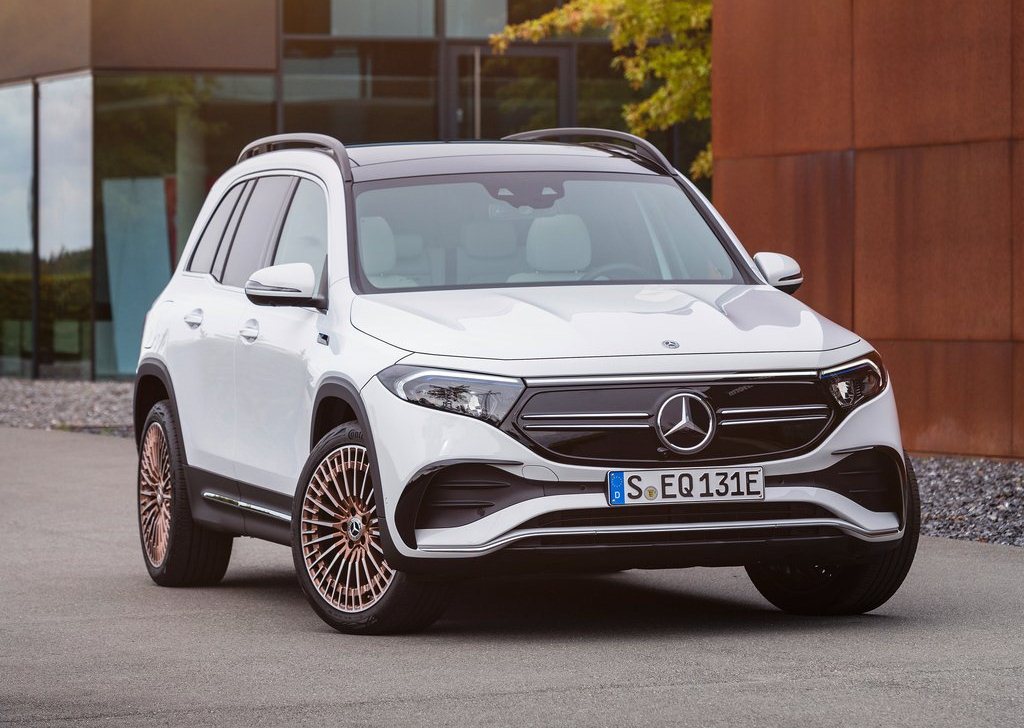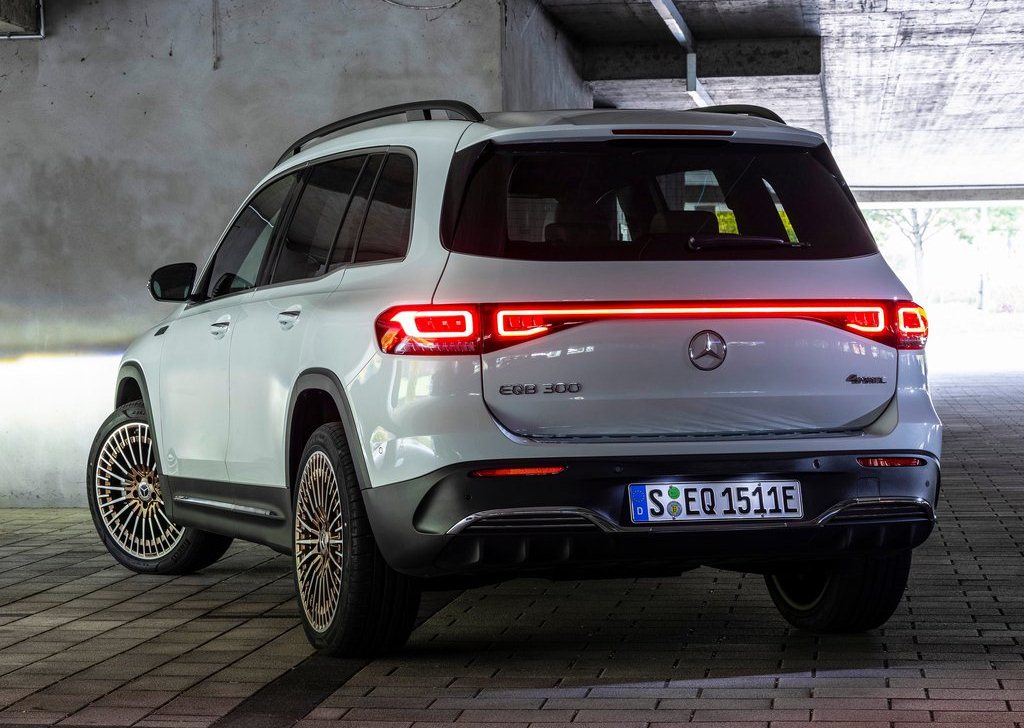Whether it's for a large nuclear family or a small extended family: as a seven-seater, the new EQB offers space for many family configurations and a wide variety of transport needs. This gives it an exceptional position among compact electric cars. The two seats in the third row can be used by people up to 1.65 metres tall, and child seats can also be fitted there. The new EQB will launch in Europe and China at the end of the year, followed by the US market launch in 2022. After the EQA, it is already the second all-electric compact car from Mercedes-EQ. The powerful and efficient electric drive, clever recuperation and predictive Navigation with Electric Intelligence are just some of the features that link it to the EQA.
The electric initiative from Mercedes-Benz Cars is accelerating as fast as the Mercedes-EQ models themselves: with the EQA, EQB, the electric business saloon EQE and the luxury saloon EQS, a total of four new models from Mercedes-EQ are being introduced in 2021, plus the Concept EQT as a harbinger of a new high level of quality in the small van segment. The Mercedes-Benz plug-in hybrid family, currently consisting of more than 20 model variants, is being renewed with electrified derivatives of the C-Class and the S-Class. For 2021, Mercedes-Benz Cars expects to increase the xEV share, i.e. of plug-in hybrids and fully electric vehicles, to around 13 percent. In addition, mild hybrids with a starter-generator and 48-volt system are conquering the product range, especially of the Group's luxury vehicles.
Generous space and variable, level boot
The EQB enriches the successful Mercedes compact car family and is closely related to two models in particular: to the EQA, whose advanced drive technology it shares, and to the GLB compact SUV. This is where the long wheelbase (2829 millimetres), the spacious and variable interior and the optional third row of seats with two additional individual seats come from.
The dimensions of the five-seater: 4684/1834/1667 millimetres (length/width/height). Space is generous. The headroom in the first row of seats is 1035 millimetres, in the second it is 979 millimetres for the five-seater. At 87 millimetres, the knee space in the rear of the five-seater reaches a comfortable level. The boot is level and spacious: the load volume of 495 to 1710 or 465 to 1620 litres (figures for five- and seven-seaters respectively) has the qualities of a Mid-range station wagon. The backrests of the seats in the second row can be adjusted in several stages as standard, and this row features fore/aft adjustment of 140 millimetres as an option. This enables the boot to be enlarged by up to 190 litres and put to versatile use.
As an option, the EQB has a third row of seats comprising two extra individual seats. The seats offer people up to a height of 1.65 metres a comfortable amount of space. Extensive safety features include retractable head restraints, seat belts with belt tensioners and force limiters on all outer seats and a side windowbag that also covers passengers in the third row. A total of up to four child seats can be fitted in rows two and three, plus one more in the front passenger seat. To increase luggage space, the third-row seats can be lowered flush into the load floor.
Electro design aesthetics brimming with character
The EQB interprets Mercedes-EQ's Progressive Luxury in an edgy and particularly characterful way. It features the characteristic Mercedes-EQ black panel grille with central star. A further distinctive design feature of the all-electric world of Mercedes-EQ vehicles is the continuous light strip at the front and rear. A horizontal fibre-optic strip connects the daytime running lights of the full-LED headlamps, ensuring a high level of recognisability both in daylight and at night. The inside of the headlamps is finished to a high level of quality, detail and precision. Blue colour highlights within the headlamp reinforce the signature Mercedes-EQ appearance.
The function-oriented greenhouse with upright windscreen makes the comfortable interior possible. Circumferential and protective cladding elements structure the overall proportion. The muscular and sensuously modelled vehicle shoulder dominates the side view, which is further enhanced by the rise of the beltline. Outwardly positioned wheels give the EQB a powerful character and confident stance on the road. Exclusive to this model are light-alloy wheels in a bi- or tri-colour design, up to 20 inches in size, in some cases with rosé gold-coloured or blue decorative trim.
The LED tail lights merge seamlessly into the tapering LED light strip. This underlines the horizontal sense of width of the EQB in the rear view. In addition, the number plate is placed on the bumper, which allows for a beautifully sculpted tailgate. The studded roof rails underline the high utility value of the new EQB.
The large body of the dashboard has a cut-out in the driver and passenger area. The driver faces a Widescreen Cockpit, with control and display via MBUX (Mercedes-Benz User Experience). The robust character of the interior is underlined by tubular elements in an aluminium look. They sit as handles in the doors, in the centre console and in the instrument panel on the passenger side.
Depending on the design and equipment line, a spectacular backlit trim piece and rosé gold-coloured decorative elements on the air vents, seats and vehicle key provide clues to the electric character in the interior of the EQB. The instruments, with their electric car-specific displays, pick up on the same colour scheme with rosé gold-coloured and blue highlights.
Suspension
As standard, the EQB features a comfort suspension with steel springs, and all versions feature a multi-link rear axle. The suspension with Adaptive Damping System (option) offers the driver the possibility of choosing their preferred damping characteristics.
The EQB features a MacPherson suspension at the front axle. The wheels are guided by control arms below each wheel centre, the MacPherson struts and two tie rods. The wishbone is forged from aluminium. This reduces the unsprung masses. The steering knuckles are made of cast aluminium.
All EQBs have a sophisticated four-link rear axle. The three transverse links and one trailing arm at each rear wheel are configured for maximum driving stability, ride comfort and longitudinal/lateral dynamics. The rear axle is supported by a subframe, which is isolated from the body shell by rubber bearings.
Two suspension variants: optional Adaptive Damping System
The EQB has a comfort suspension with steel springs as standard. A suspension with Adaptive Damping System is available as an option. This offers the driver the possibility of selecting the damper characteristics on an individual basis via the driving program. A valve in each of the four shock absorbers is electronically actuated to control the oil flow. The damping characteristics are changed by regulation of the oil flow. The Comfort program comes into its own especially when travelling at low speeds, for example on a cobblestone road.
Several sensors constantly monitor the suspension status, driving situation and driving style of the driver, and adjust the damping at each wheel. They also provide information about the drive system, recuperation and braking system, steering, and the driving assistance systems. The damping is specifically stiffened during acceleration, braking or steering manoeuvres to reduce pitching and body roll, and to improve wheel loads and the ground contact of the tyres.
More traction: 4MATIC all-wheel drive
The EQB 300 4MATIC and EQB 350 4MATIC have all-wheel drive. The 4MATIC system uses Torque Shift: the distribution of the torque is adjusted 100 times per second as required on a continuously variable basis between the two electric units at the front and rear axles. If the driver does not call for the full output, the motor that is not needed will be completely switched off in order to reduce the base load. In a low load range therefore, the reliance will be on the rear axle with the more efficient, permanently excited synchronous motor (PSM). Higher performance requirements will be met through the additional activation of the asynchronous motor (ASM) on the front axle.
In order to ensure maximum traction and driving stability even on snow and ice, the operating strategy reacts to spinning wheels and adjusts the torque distribution accordingly. Since the two motors are controlled independently of each other, a loss of traction on one axle does not preclude torque being sent to the respective other axle - much as with a conventional central differential lock.








![2026 Audi Q3 Sportback e-hybrid [UK] – The Company Car King Returns?](https://blogger.googleusercontent.com/img/b/R29vZ2xl/AVvXsEhhX1IQuUgqvEH4uwfrPZQ-MCX8r2U7x-9jj77v6wKNQyNY4U_9reoVpPCSYn0CmBFEIaBi4x8oa3uceJZWKTggl5B_DFi9tbcViJwKv1pphzQB-Ud2wASBGForMOfhjhtTFdHhlmxLdpaljRS-LyPmACMKJ496qqBzeh-M-dhBcorzWd2vfmymhhtwMX8j/w680/2026%20Audi%20Q3%20Sportback%20e-hybrid%20%5BUK%5D_01.jpg)










![2026 Kia Sportage [EU] Review: A Refined European Crossover with Bold Style and Electrified Options](https://blogger.googleusercontent.com/img/b/R29vZ2xl/AVvXsEgqMRwJE1m90uCMgRSB6oc4bAzmAaKXJlNoCwavK5fXHaphLYY1sUVXdxUC94zuj95CdjDG2SqRnUBYMqta-dapTLIaHhzEdJAS821ldVMQOKfAZNpQlZ5fYTwKzKbKj8ad9QeKlaQPcNLRZ6zaGvuXhsg1kQ6zQCQqYtjmOM8q9u-a7Nl3WYjp773OLXJR/w680/2026%20Kia%20Sportage%20%5BEU%5D_01.jpg)



0 Comments